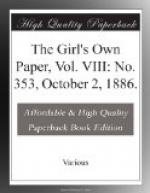Oriental embroidery cannot be made up in so many different ways as Leek embroidery, but it is quite new, and aims at reproducing early Eastern designs. The foundation material is surah silk, the silk sold in large squares as Liberty’s handkerchief being correct in colouring and texture. Upon this foundation the patterns, which all consist of single petalled flowers resembling single dahlias, sunflowers, or chrysanthemums, are worked with Oriental silk, which are silks of a thick make, but very soft and with a gloss on them similar to the gloss on floss silk. The leaves surrounding the flowers are of the shape of the jessamine, and to these are added tendrils and queer-looking bunches of seed-vessels.
There is little variety in the design, as the embroidery is entirely executed in one stitch (that of a close herringbone), but there is great variety and great scope for good shading in the colouring. Oriental silks are all dyed in the shades of blues, yellow pinks, terra-cotta reds, and brilliant yellows, to be seen in Eastern embroideries worked before the introduction of aniline dyes, and the consequent lapse into Imperial purples and magentas and royal blues.
By a judicious use of good colours the same design can be so repeated as to look entirely different. Thus, a spray of flowers worked upon an orange-red ground, with cream, yellow, pink and pale blue colours, will be quite distinct from the same spray laid upon sea-green silk, and coloured with deep orange-reds and blues running from sky into navy blue.
As before mentioned, the only stitch used is herringboning, and the only flowers single petalled ones; but the herringboning is done so closely together that it looks like an interwoven stitch of double crossings, and the flowers are all worked in their centres in a different silk to that used on their tips, and therefore resemble double petalled flowers. The tips of each petal are wider than the commencement, and the herringboning is not taken along as a wide line of equal width, but as a curved line running small, and widening out again several times if the petal or seed-vessel is a long one. Each petal is worked separately, and the silk is never dragged or drawn tightly, but is allowed to lie easily over the foundation, and rather loosely, although the stitches follow each other so closely that nothing of the foundation can be seen where they are laid. The stems, long leaves, and large branches are worked as closely as the petals in herringbone, but tendrils and sprays are more opened out, and are given the look of single coral stitch as a variety.
When shading a flower select two colours that are distinct in tone but not jarring in their contrast; thus, cream-white used for the outer petals can be finished with pale blue, yellow pink, pure orange, or pale yellow for its centre petals; scarlet red outside petals with black inner petals, bright blue outside petals with lemon yellow or terra-cotta red inside petals, and every one of these colours are allowable when working bunches of flowers scattered over the whole of a five o’clock tea-cloth or fireplace curtains.




